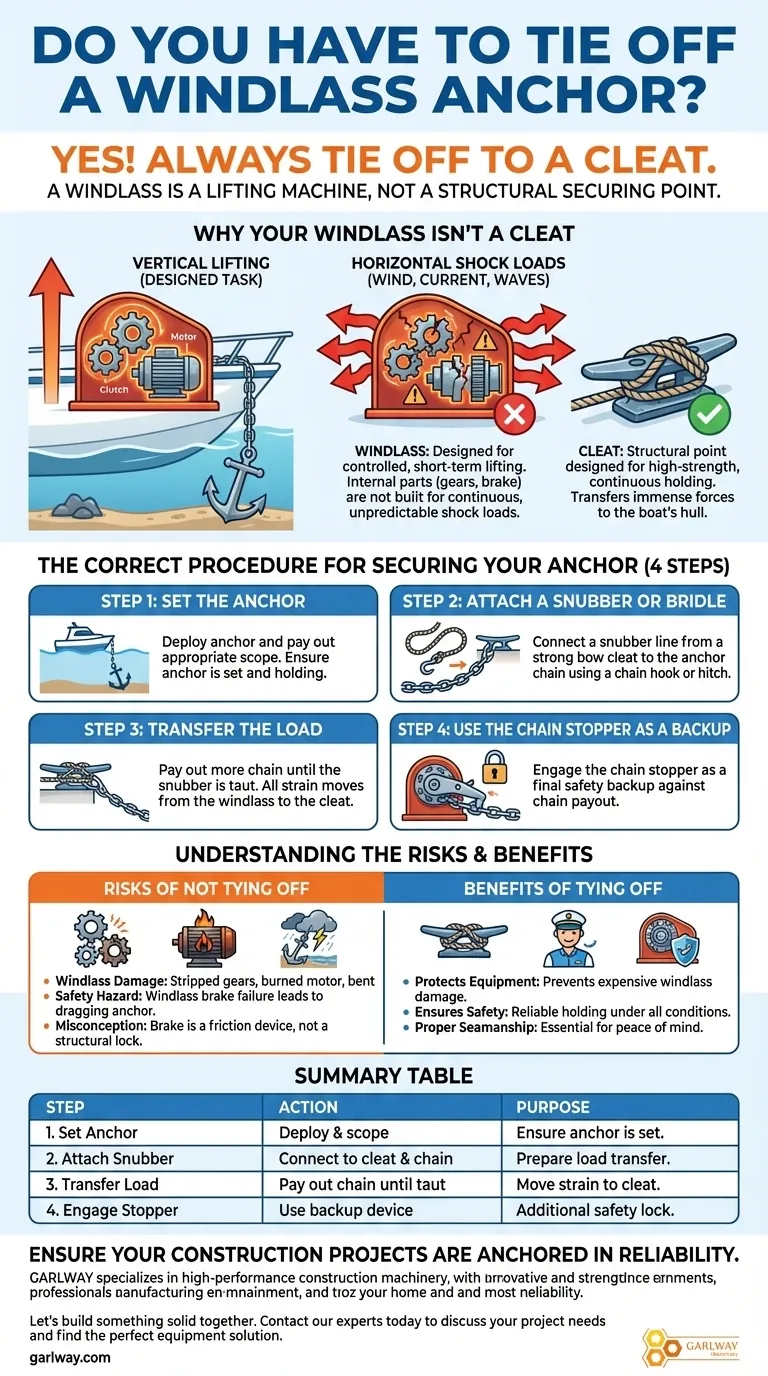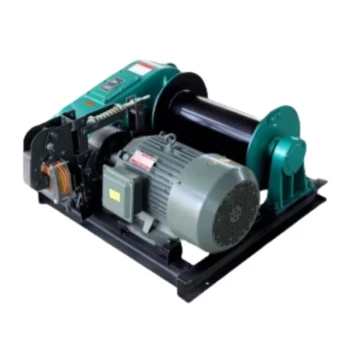Yes, you must always tie off your anchor rode to a cleat or other strong point. A windlass is a powerful machine designed exclusively for raising and lowering the anchor; it is not engineered to bear the continuous and dynamic loads of a boat at anchor. Relying on the windlass to hold the boat puts immense stress on its internal components, leading to premature wear, catastrophic failure, and an unsafe anchoring situation.
Your anchor windlass is a lifting device, not a structural securing point. The immense force of your boat straining against wind and current must be transferred from the windlass to a dedicated, load-bearing cleat on your boat's deck.

Why Your Windlass Isn't a Cleat
Understanding the specific job of a windlass and its components makes it clear why it cannot be used as a permanent securing point. Its design is fundamentally at odds with the forces it would face.
The Windlass's True Job: Lifting and Lowering
A windlass is a complex piece of machinery with a gearmotor and other components designed to multiply force for one primary task: vertical lifting.
Its internal gears, clutch, and motor are engineered to handle the controlled, short-term strain of hauling the weight of the anchor and chain from the seabed.
The Forces at Play on an Anchored Boat
A boat at anchor is subjected to immense and unpredictable horizontal forces. Wind gusts, current shifts, and wave action create powerful, jerking loads that can far exceed the static weight of the anchor rode.
These are not the steady lifting forces a windlass is built for. They are shock loads that will punish the internal gears and brake system.
The Role of the Gypsy and Brake
The gypsy (or wildcat) is the specially shaped wheel that grips the anchor chain links. Its teeth are designed to engage the chain for smooth retrieval and deployment.
The brake system is designed to control the speed of the chain during deployment, not to act as a permanent, high-strength lock against the pull of an entire vessel.
The Correct Procedure for Securing Your Anchor
Transferring the load from the windlass to a structural point on the boat is a non-negotiable step for safe anchoring.
Step 1: Set the Anchor
Deploy your anchor and pay out the appropriate scope. Once you are confident the anchor is set and holding, your boat will be resting on the windlass.
Step 2: Attach a Snubber or Bridle
Take a separate line, known as a snubber (for an all-chain rode), and attach it to a strong bow cleat. The other end is attached to the anchor chain using a special hook, like a chain hook or rolling hitch.
Step 3: Transfer the Load
Pay out a little more anchor chain until the snubber line becomes taut. You will see the load transfer from the windlass to the snubber and cleat. The anchor chain running through the windlass should now be slack.
This action takes all the strain off the windlass and places it onto the cleat, which is a structural part of the hull designed for exactly this purpose. The nylon snubber also provides valuable shock absorption.
Step 4: Use the Chain Stopper as a Backup
Many boats are equipped with a chain stopper or pawl bar. This metal flap or lever physically blocks the chain from paying out further. It should be engaged as a final backup measure after the load is on the snubber.
Understanding the Risks of Not Tying Off
Failing to transfer the load from the windlass is not a minor oversight; it introduces significant risk to your equipment and your safety.
The Risk of Windlass Damage
Leaving the load on the windlass can cause severe and expensive damage. This includes stripped gears, a burned-out electric motor, a bent main shaft, or even cracking the deck where the windlass is mounted.
The Safety Hazard of a Dragging Anchor
The ultimate failure is the windlass brake or gears giving way under a sudden shock load, causing the anchor to drag. A dragging anchor in a storm or a crowded anchorage is one of the most dangerous situations a boater can face.
A Common Misconception
Never assume the windlass brake is "strong enough" to hold. It is a friction device meant for controlled lowering, not a positive lock capable of withstanding the thousands of pounds of force a boat can exert in heavy weather.
Making the Right Choice for Your Anchor
Following the correct procedure is simple and ensures the longevity of your equipment and the safety of your vessel.
- If your primary focus is protecting your equipment: Always use a snubber attached to a cleat to completely remove the anchoring load from the windlass gears and motor.
- If your primary focus is safety in all conditions: Transferring the load to a structural cleat is the only reliable way to ensure your anchor holds securely and does not fail under stress.
- If your primary focus is proper seamanship: Making the anchor fast to a cleat is a fundamental and non-negotiable step in the anchoring process for any experienced mariner.
Properly securing your anchor to a strong point protects your boat, your crew, and your peace of mind on the water.
Summary Table:
| Step | Action | Purpose |
|---|---|---|
| 1. Set Anchor | Deploy anchor and pay out scope. | Ensure the anchor is properly set on the seabed. |
| 2. Attach Snubber | Connect a snubber line from a cleat to the chain. | Prepare to transfer the load away from the windlass. |
| 3. Transfer Load | Pay out chain until the snubber is taut. | Move all strain from the windlass to the structural cleat. |
| 4. Engage Stopper | Use the chain stopper as a backup. | Provide an additional safety lock against chain payout. |
Ensure your construction projects are anchored in reliability. Just as a boater needs the right equipment for safety, your construction company needs durable, powerful machinery for success. GARLWAY specializes in high-performance construction machinery, including winches, concrete mixers, and batching plants, designed to handle heavy loads and demanding conditions. Let's build something solid together. Contact our experts today to discuss your project needs and find the perfect equipment solution.
Visual Guide

Related Products
- Heavy Duty Electric Boat Winch Windlass Anchor
- Electric Hoist Winch Boat Anchor Windlass for Marine Applications
- Warn Winch Windlass Boat Trailer Winch
- Commercial Construction Mixer Machine for Soil Cement Mixing Concrete
- Hydraulic Winding Engine Harbor Freight Winch
People Also Ask
- How does the anchor windlass operation sequence work? Master Safe & Controlled Anchor Handling
- What are marine electric winches and their characteristics? Key Features for Reliable Maritime Operations
- What are some challenges with windlass type winches? Key Issues in Rode Matching and Operation
- How does a boat anchor winch work? A Guide to Reliable Anchor Handling
- What are the main benefits of a boat anchor winch? Boost Safety & Efficiency for Your Vessel





